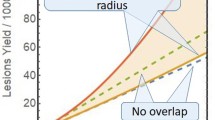Summary
Cell survival was studied by analyzing the inactivation probability density function and its fundamental parameters. Mean\(\bar D\), varianceσ 2 and modeD mode were evaluated and a set of equations relating these parameters to the usual parameters of the multitarget, multihit and linear-quadratic modelsD o andn, α andβ, k andλ are reported. The multihit equation used was an extension of the usual equation, to allow parameterk to assume values that are not necessarily integers. In the multitarget curve, the mode of inactivation probability density function, proved to be the quasi-threshold doseD q =D o ln(n). Relative variance, degree of asymmetry and degree of peakedness can be calculated from the shape parametersn in the multitarget model,k in the multihit model, and\(\alpha /\sqrt \beta \) in the linear-quadratic model. From an analysis of eight published cell survival sets of data, on C3H10T1/2 cells exposed to low LET radiations, it was found that\(\bar D\),σ, andSF 2 are the parameters which exhibit the least variation from experiment to experiment and the least variation in selecting the range of data available for estimation.
Similar content being viewed by others
References
Alper T, Fowler JF, Morgan RL, Vonberg OO, Ellis F, Oliver R (1962) The characteristics of the “type C” survival curve. Br J Radiol 35:722–723
Balcer-Kubiczeck EK, Harrison GH (1983) Oncogenic transformation of C3H10T1/2 by X-rays, fast-fission neutrons and cyclotron-produced neutrons. Int J Radiat Biol 44:377–388
Bettega D, Tallone Lombardi L (1983) Physical and radiobiological parameters of proton beams up to 31 MeV. Nuovo Cimento 2D:907–916
Bettega D, Calzolari P, Pollara P, Tallone Lombardi L (1985) In vitro cell transformations induced by 31 MeV protons. Radiat Res 104:178–181
Deacon J, Peckham MJ, Steel GG (1984) The radioresponsiveness of human tumors an the initial slope of the cell survival curve. Radiother Oncol 2:317–323
Elkind MM (1988) The initial part of the survival curve: does it predict the outcome of fractionated radiotherapy? Radiat Res 144:425–436
Fertil B, Malaise EP (1981) Inherent cellular radiosensitivity as a basic concept for human tumor radiotherapy. Radiat Oncol Biol Phys 7:621–629
Fertil B, Malaise EP (1985) Intrinsic radiosensitivity of human cell lines is correlated with radioresponsiveness of human tumors: analysis of 101 published survival curves. Int J Radiat Biol Phys 11:1699–1707
Fertil B, Dertinger H, Courdi A, Malaise EE (1984) Mean inactivation dose: a useful concept for intercomparison of human cell survival curves. Radiat Res 99:73–74
Han A, Elkind MM (1979) Transformation of mouse C3H10T1/2 cells by single and fractional doses of X-rays and fission-spectrum neutrons. Cancer Res 39:123–130
Han A, Hill CK, Elkind MM (1980) Repair of cell killing and neoplastic transformation at reduced dose rates of60Coγ rays. Cancer Res 40:3328–3332
Hastings Jr C (1955) Approximation for digital computers. Princeton University Press, Princeton, NJ
Hieber, L, Ponsel G, Roos H, Fenn S, Fromke E, Kellerer AM (1987) Absence of a dose-rate effect in the transformation of C3H10T1/2 cells byα-particles. Int J Radiat Biol 52:859–869
ICRU (1979) Quantitative concepts and dosimetry in radiobiology. Report No 30. International Commission on Radiation Units and Measurements, Washington, DC
Kellerer AM, Hug O (1972) Theory of dose-effect relationships. In: Encyclopedia of medical radiobiology, vol 2. Springer, Berlin Heidelberg New York, pp 1–42
Malaise EP, Fertil B, Chavaudra N, Guichard M (1986) Distribution of radiation sensitivities for human tumor cells of specific histological types: comparison of in vitro to in vivo data. Int J Radiat Oncol Biol Phys 12:617–624
Miller RC, Hall EJ, Rossi HH (1979) Oncogenic transformation of mammalian cells in vitro with split doses of X-rays. Proc Natl Acad Sci USA 76:5755–5758
Roberts CJ, Goodhead DT (1987) The effect of238Puα-particles on the mouse fibroblast cell line C3H10T1/2: characterization of source and RBE for cell survival. Int J Radiat Biol 52:871–882
Steel GG, McMillan TJ, Peacock JH (1989) The picture has changed in the 1980s. Int J Radiat Biol 56:525–537
Terzaghi M and Little JB (1976) X-radiation-induced transformation in a C3H mouse embryo-derived cell line. Cancer Res 36:136–1374
Tucker SL (1986) Is the mean inactivation dose a good measure of cell radiosensitivity? Radiat Res 105:18–26
Weichselbaum RR, Rotmensch J, Ahmed-Swan S, Beckett MA (1989) Radiobiological characterization of 53 human tumor cell lines. Int J Radiat Biol 56:553–560
Author information
Authors and Affiliations
Rights and permissions
About this article
Cite this article
Bettega, D., Calzolari, P., Ottolenghi, A. et al. Criteria and techniques for analysing cell survival data. Radiat Environ Biophys 30, 53–70 (1991). https://doi.org/10.1007/BF01595574
Received:
Accepted:
Issue Date:
DOI: https://doi.org/10.1007/BF01595574




